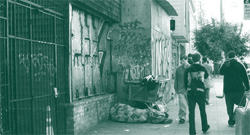December/January 2009
In this Issue
Closing the Distance Between Home and Work
Renewing Hope for Small Industrial Cities
A Clearer National Perspective on Homelessness
Helping Scholars Pursue Timely Research
In the next issue of ResearchWorks
A Clearer National Perspective on Homelessness
As communities standardize their reporting and data collection efforts, a national picture of homelessness is gradually emerging in the United States. HUD is assisting these efforts through development of a nationwide Homeless Management Information System (HMIS), a data collection tool that stores person-level information about homeless people who access a given community's homeless services. The HMIS arose out of a series of congressional directives requiring the collection of standardized information on characteristics such as the pattern of shelter usage, length of stay, ethnicity, age, and service needs of homeless people.
Two types of communities have contributed data to HMIS collection efforts: representative national sample communities, known as sample sites, and communities with advanced HMIS systems that are not part of the national sample, called contributing communities. For the first time, data were collected for a full year from both sample sites and contributing communities. Although some limitations — such as changes in study methodologies and sampling errors — should be noted, a full year of data provides a better understanding of the scope and nature of homelessness and the services available. Twelve months of location-specific data also allow researchers to create a baseline for comparing the number of homeless people, their characteristics, and their patterns of service use.
The Third Annual Homeless Assessment Report to Congress, published by HUD, is based on HMIS data collected from more groups than ever before — 61 sample sites and 37 contributing communities. These longitudinal data, in conjunction with a point-in-time estimate made on a single night in January 2007, help illustrate the scope of the problem. This most recent report provides information on seasonal patterns of homelessness, long-term shelter users, and, for the first time, community-level homelessness. The additional sample sites and data also allow a limited amount of analysis at the city, suburban, and rural levels.

On that January night, 671,888 homeless people were counted across the nation. Nearly 60 percent of them were in emergency shelters or transitional housing. The others were on the streets or in other places not intended for human habitation. Although homeless individuals were just as likely to be sheltered as on the streets, 72 percent of families were in shelters.
On that night, 123,833 of those individuals counted were chronically homeless, meaning "[a]n unaccompanied individual with a disabling condition who has been continuously homeless for a year or more or has experienced four or more episodes of homelessness over the past 3 years."1 Two-thirds of this subpopulation were on the streets, rather than housed in shelters.
According to HMIS data, nearly 1.6 million people used emergency or transitional shelters between October 1, 2006 and September 30, 2007; of these, 70 percent were not accompanied by families or children. When asked about their shelter status the previous night, 58 percent of individuals and 42 percent of families were already homeless (e.g., living in another shelter or in places not meant for human habitation). Of those not already homeless, more than half became homeless after overstaying their welcome in someone else's home.
More than three-quarters (78%) of those seeking accommodation throughout the year found it exclusively in emergency shelters, whereas 16 percent used only transitional housing; 6 percent used both. On an average day, a larger percentage of emergency shelter beds (94%) were occupied than were transitional housing beds (78%). According to the report, "to the extent that homelessness is mostly an episodic or short-term phenomenon, the higher average daily utilization rates in emergency shelters is expected" (p. 52). In contrast, transitional housing beds are often set aside for a specific subpopulation, and are therefore more likely to remain vacant until an eligible client arrives seeking services.
The HMIS data also show that the sheltered homeless are predominantly in urban areas (77%) and that they are more likely to be males (69%) and in their middle years (55%). Individual women are more frequently found in transitional housing, making up one-third of those in that type of housing, although they only make up one-quarter of sheltered homeless individuals. By contrast, men are more often found in emergency housing. In general, African American, Hispanic/Latino, and Native American individuals are overrepresented in the homeless population compared with their presence in the population of the poor.
Researchers and practitioners will one day be able to use the data provided in this report as a baseline for measuring changes in the nature and scope of homelessness over time. In future reports, readers can expect to find information from other homeless providers (street outreach and permanent supportive housing providers), as well as special reports on selected subpopulations or new information on certain types of programs.
Other data contributing to a more detailed national picture of homelessness are reported in The Third Annual Homeless Assessment Report to Congress. This study is available at no cost through HUD's Homelessness Resource Exchange at www.hudhre.info/documents/3rdHomelessAssessmentReport.pdf. Earlier annual versions of The Annual Homeless Assessment Report to Congress are also available as free downloads at www.huduser.gov/publications/povsoc/annual_assess.html and www.hudhre.info/ documents/2ndHomelessAssessmentReport.pdf.
1. U.S. Department of Housing and Urban Development, U.S. Department of Health and Human Services, and Department of Veterans Affairs. "Notice of Funding Availability (NOFA) for the Collaborative Initiative To Help End Chronic Homelessness." 68 Federal Register 4017, January 27, 2003.

